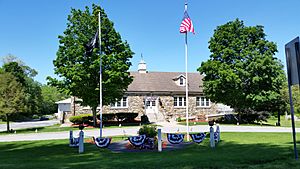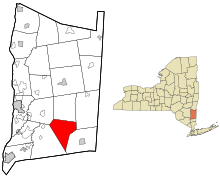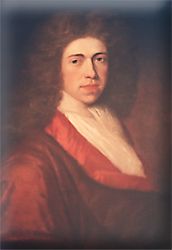Beekman, New York facts for kids
Quick facts for kids
Beekman, New York
|
||
|---|---|---|

Beekman Town Hall in 2017
|
||
|
||
| Motto(s):
"One of the Original Towns"
|
||

Location of Beekman, New York
|
||
| Country | United States | |
| State | New York | |
| County | Dutchess | |
| Established | 1788 | |
| Government | ||
| • Type | Town Council | |
| Area | ||
| • Total | 30.36 sq mi (78.62 km2) | |
| • Land | 29.84 sq mi (77.28 km2) | |
| • Water | 0.52 sq mi (1.34 km2) | |
| Elevation | 430 ft (131 m) | |
| Population
(2010)
|
||
| • Total | 14,621 | |
| • Estimate
(2016)
|
14,385 | |
| • Density | 482.10/sq mi (186.14/km2) | |
| Time zone | UTC−5 (Eastern (EST)) | |
| • Summer (DST) | UTC−4 (EDT) | |
| ZIP Codes |
12570, 12533
|
|
| Area code(s) | 845 | |
| FIPS code | 36-027-05452 | |
| GNIS feature ID | 0978718 | |
Beekman is a town in Dutchess County, New York, United States. It is part of the Poughkeepsie–Newburgh–Middletown, NY Metropolitan Statistical Area as well as the larger New York–Newark–Bridgeport, NY-NJ-CT-PA Combined Statistical Area. The population was 14,621 at the 2010 census. The town was named after Henry Beekman, a 17th-century land owner.
Contents
History
The "Beekman" name became attached to the area in 1697, from Henry Beekman, a Kingston native, who had numerous land stakes in Dutchess County. The town had also been occupied by the Wappinger Indians, before the first European settlers arrived around 1710. The Beekman Patent, granted to Beekman in 1697, was the second largest land holding in Dutchess County. In 1737, Beekman became an official precinct, and local government was erected. 1788 was the initial period of establishing towns and counties in the newly independent state of New York, but parts were removed subsequently to form other towns. Beekman contributed part of its territory to the newer towns of LaGrange (1821) and Union Vale (1827). Iron ore extraction and smelting were important in the early economy. The Beekman Patent was a manor until after the Revolution. Residents could only lease the land and pay rent in wheat, fat fowls and work on roads. The series Settlers of the Beekman Patent chronicles the lives of all residents there in the 18th century.
Beekman saw its first place of worship shortly thereafter, a Lutheran church located off Beach Road, which was frequented by German emigrants. The Quaker family, well known in the area for being one of the initial settlers, created a meeting house in 1771 in Gardner Hollow, named the "Apoquague Preparative Meeting". The church attracted most of the population at the time, and those who did not worship there frequented St. Denis Church, a Catholic church, just beyond the East Fishkill border.
Late 19th century
Beekman began its "boom" in the late 19th and early 20th centuries as the communities of Sylvan Lake, Beekmanville, and Clove Valley were in the active mining business. Many townsfolk that settled in town during this time were Irish men, escaping the Potato Famine, and sent their families to Beekman as well. However, the mining industry died out in the late 19th century, with very few remains today. The most notable one, the "Beekman Furnace", is still intact on Furnace Road, just off Clove Valley Road.
Beekman in the 20th century
After the demise of the mining business in the late 19th century, Beekman saw another boom in the 20th century, with housing developments such as Dalton Farm, the first gas stations, and construction of the first supermarket in town, Shoprite (now Stop & Shop), signalling the beginning of suburban development.
Today Beekman has a total population of 14,000, being one of the fastest growing towns in the entire country. Comparatively few farms remain, and commerce and industry increasingly shape the non-residential areas of the town.
Geography
Beekman is located in the southeastern part of Dutchess County, about 70 miles (110 km) north of New York City. According to the United States Census Bureau, the town has a total area of 30.3 square miles (78.6 km2), of which 29.8 square miles (77.3 km2) is land and 0.50 square miles (1.3 km2), or 1.45%, is water. Most of the town is drained by Fishkill Creek, which flows west to the Hudson River at Beacon. The southern corner of the town is drained by Stump Pond Creek, part of the Croton River watershed that flows to the Hudson at Croton-on-Hudson.
Demographics
| Historical population | |||
|---|---|---|---|
| Census | Pop. | %± | |
| 1820 | 4,257 | — | |
| 1830 | 1,584 | −62.8% | |
| 1840 | 1,400 | −11.6% | |
| 1850 | 1,386 | −1.0% | |
| 1860 | 1,371 | −1.1% | |
| 1870 | 1,486 | 8.4% | |
| 1880 | 1,578 | 6.2% | |
| 1890 | 1,113 | −29.5% | |
| 1900 | 1,071 | −3.8% | |
| 1910 | 827 | −22.8% | |
| 1920 | 844 | 2.1% | |
| 1930 | 764 | −9.5% | |
| 1940 | 790 | 3.4% | |
| 1950 | 1,703 | 115.6% | |
| 1960 | 3,326 | 95.3% | |
| 1970 | 5,701 | 71.4% | |
| 1980 | 7,139 | 25.2% | |
| 1990 | 10,447 | 46.3% | |
| 2000 | 13,655 | 30.7% | |
| 2010 | 14,621 | 7.1% | |
| 2016 (est.) | 14,385 | −1.6% | |
| U.S. Decennial Census | |||
As of the census of 2000, there were 11,452 people, 3,751 households, and 3,034 families residing in the town. The population density was 381.7 people per square mile (147.4/km2). There were 4,180 housing units at an average density of 139.3 per square mile (53.8/km2). The racial makeup of the town was 93.24% white, 2.42% African American, .18% Native American, 1.73% Asian, .03% Pacific Islander, .94% from other races, and 1.46% from two or more races. Hispanic or Latino of any race were 5.38% of the population.
There were 3,751 households, out of which 46.3% had children under the age of 18 living with them, 70.0% were married couples living together, 7.7% had a female householder with no husband present, and 19.1% were non-families. 14.3% of all households were made up of individuals, and 3.8% had someone living alone who was 65 years of age or older. The average household size was 3.04 and the average family size was 3.41.
In the town, the population was spread out, with 30.9% under the age of 18, 6.1% from 18 to 24, 33.2% from 25 to 44, 22.3% from 45 to 64, and 7.5% who were 65 years of age or older. The median age was 36 years. For every 100 females, there were 100.6 males. For every 100 females age 18 and over, there were 98.1 males.
The median income for a household in the town was $65,610, and the median income for a family was $72,066. Males had a median income of $51,739 versus $32,119 for females. The per capita income for the town was $26,437. About 3.6% of families and 4.7% of the population were below the poverty line, including 5.3% of those under age 18 and 5.4% of those age 65 or over.
Transportation
Road
Although Beekman has no major highways, it does have two major thoroughfares. New York State Route 55 crosses from the Pawling town line to the Union Vale town line and is a direct route northwest into the city of Poughkeepsie. Route 216 goes from Route 55 into the town of East Fishkill where it meets Route 52.
Rail
Metro-North Railroad's Beacon Line runs through the south end of town along Greenhaven Road and Depot Hill Road. It is currently a non-revenue line with no station stops, but is used for equipment moves between Beacon, Southeast and Danbury.
Communities and locations in Beekman
- Beekman – The hamlet of Beekman is near the town center on Route 216 with the intersection of Routes 216 and 55 its east boundary. It was formerly known as "Beekmanville."
- Clove Valley – A hamlet in the northeast part of the town on Route 216.
- Green Haven – A hamlet south of Beekman village.
- Green Haven Correctional Facility – A state prison near the community of Green Haven.
- Poughquag – A hamlet east of Beekman village, running along Route 55 with that road's intersection with Route 216 its boundary with Beekman and Clove Valley. It is the main business district of the town and home of Beekman town hall. Murphy Grist Mill was added to the National Register of Historic Places in 2015.
- Sylvan Lake – A hamlet by the west town line. It is named after Sylvan Lake, which was formed during the ice age. The early Indians originally named it Poughquag, which means "round body of water". A smaller lake known as Hidden Lake is where Mr. Daniel Delany, in the late 19th century, discovered iron ore and made his fortune. He eventually bought the adjacent property which was the entire shoreline of Sylvan Lake and rebuilt St. Denis church for the town. Some iron ore mining also took place along the shores of Sylvan Lake in the early 1930s and some of these retainer wall pilings are still standing and can be clearly seen from a boat. When the mine was filled with water, construction equipment and mining tools were left on the bottom, and are present today.
Notable person
- Dan Brouthers, former Major League Baseball player, was born in Sylvan Lake
Images for kids
See also
 In Spanish: Beekman para niños
In Spanish: Beekman para niños




